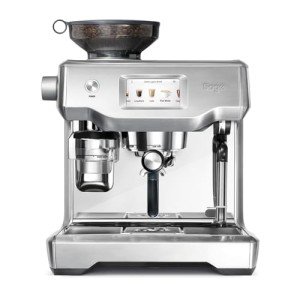The Art of Italian Espresso Machines: A Brewed Tradition
Italian espresso machines are not just home appliances; they are an important part of Italy's rich coffee culture, representing a blend of artistry, engineering, and design. Espresso Machines With Grinder around the globe acknowledge the importance of high-quality espresso, a staple of Italian life and cuisine. This article explores the history, mechanics, types, and aspects to think about when buying an Italian espresso machine, showing the depth of this precious drink and its brewing approaches.
History of Espresso Machines
The espresso machine's evolution dates back to the early 20th century in Italy, where coffee was not merely a beverage but a necessary social ritual. The initial efforts to brew espresso begun with simple, stove-top models, gradually developing into complex machines that might replicate the ideal brew.
- 1901-- The First Espresso Machine: The very first steam-powered espresso machine, referred to as the "Ideale," was developed by Luigi Bezzera. This equipment marked a turning point in espresso developing.
- 1938-- The Lever Machine: The intro of the lever machine made it easier to manage the pressure used in espresso extraction, enhancing taste consistency.
- 1947-- The Automatic Machine: Reaching more consumers, Gaggia launched the very first automatic espresso machine, further promoting espresso bars.
- 2007-- The Digital Age: Technological developments led to the birth of fully programmable machines, permitting users to tailor their developing settings to attain a personalized coffee experience.
Key Features of Italian Espresso Machines
Italian espresso machines embody precision, workmanship, and development. Here are some essential elements that highlight their significance:
| Feature | Description |
|---|---|
| Boiler Type | Determines how heat is created and kept. Common types consist of single boiler, dual boiler, and heat exchanger. |
| Group Heads | Where the coffee is brewed; commercial machines typically have several group heads for efficiency. |
| Pressure Control | Vital for achieving the ideal espresso; most machines operate at 9 bars of pressure. |
| Frothing Capabilities | The steam wand enables for milk frothing, essential for drinks like cappuccino and latte. |
| Construct Quality | The products utilized (stainless steel, brass, and so on) impact sturdiness and heat retention. |
Kinds Of Italian Espresso Machines
Selecting the best machine depends upon user choices, budget, and meant use. Below are the primary types of Italian espresso machines:
Manual Espresso Machines
- Pros: Offer full control over the developing procedure, permitting for an individualized touch.
- Cons: Require ability and practice, can be labor-intensive.
Semi-Automatic Machines
- Pros: Provide a balance between automated and manual procedures; users manage water flow.
- Cons: Can have a steeper knowing curve than fully automatic machines.
Totally Automatic Machines
- Pros: Simplify the brewing procedure with push-button operations; suitable for novices.
- Cons: May compromise a few of the subtleties of manual brewing.
Super-Automatic Machines
- Pros: Grind, tamp, brew, and froth instantly; hassle-free for hectic way of lives.
- Cons: Less control over the brewing variables, capacity for a less genuine espresso experience.
Purchasing Guide: Factors to Consider
Choosing the ideal Italian espresso machine can be difficult, however considering the following elements can streamline the decision-making process:
- Budget: Italian espresso machines range from affordable to high-end models, so set a budget upfront.
- Use Frequency: Evaluate how typically you will use the machine; daily users may desire a more long lasting option.
- Area: Measure your cooking area or counter space; some machines can be large and need enough clearance.
- Upkeep: Consider ease of cleansing; machines with removable parts or built-in cleaning features might reduce maintenance.
- User Skill Level: Beginners may choose completely or semi-automatic machines, while knowledgeable baristas can deal with manual machines.
- Brand name Reputation: Research brands understood for quality, such as Breville, Gaggia, and La Marzocco.
Popular Italian Espresso Machine Brands
Italian workmanship is renowned for producing a few of the very best espresso machines worldwide. Here are top brands worth thinking about:
- Gaggia: Known for its home espresso machines and cost.
- La Marzocco: A premium brand understood for its commercial-grade machines and innovative technology.
- Rancilio: Renowned for its resilient build and professional-quality machines appropriate for home and commercial use.
- Sage/Breville: Offers advanced features and user-friendly styles, perfect for both novices and lovers.
Frequently asked questions
What is the distinction between espresso and routine coffee?
Espresso is a focused coffee brewed by requiring warm water through finely-ground coffee under pressure. It has a thicker consistency, richer flavor, and higher caffeine concentration than routine coffee.
Can I make milk-based drinks with an espresso machine?
Yes, lots of Italian espresso machines come with a steam wand to froth milk for beverages like coffees, lattes, and macchiatos.
How frequently should I clean my espresso machine?
Routine maintenance is important. Usually, a thorough cleaning is advised every few weeks, while descaling should be done every 1 to 3 months, depending on water solidity.
What is the ideal pressure for brewing espresso?
The perfect pressure for developing espresso is around 9 bars. This pressure ensures the optimum extraction of tastes from the coffee grounds.
Are more costly machines worth the investment?
Higher-end machines frequently utilize better materials and technology, providing enhanced resilience and more consistent outcomes. For major coffee enthusiasts, investing in an excellent machine can elevate the espresso experience considerably.
Italian espresso machines are much more than simple brewing devices; they are a celebration of a cultural tradition that has actually influenced coffee consumption worldwide. With various models offered to fit any user's requirements-- ranging from newbies to seasoned baristas-- there is an Italian espresso machine completely fit for everybody. As you embark on your espresso journey, understanding the history, mechanics, and choices will enrich your experience and appreciation for this time-honored drink. Whether you look for to recreate a café ambiance at home or refine your brewing technique, these machines can providing unforgettable cups of espresso decorated with the rich history of Italian coffee culture.

